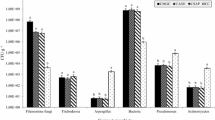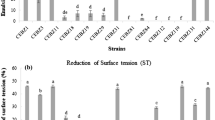Abstract
One-hundred and one microorganisms have been selected and tested for their antagonistic activity towards soil-borne plant pathogens from a compost originated from urban organic and yard wastes. Among them, twenty eight microorganisms, tested under laboratory conditions on tomato seedlings growing on perlite medium in Petri plates, controlled tomato wilt caused by Fusarium oxysporum f. sp. radicis-lycopersici. In a second round of trials, they were assessed under greenhouse condition on three pathosystems: Fusarium oxysporum f.sp. basilici on basil, Phytophthora nicotianae on tomato and Rhizoctonia solani on bean. The Fusarium strain K5 showed a disease control of 69% and an increase in biomass production of basil of 32% compared to inoculated control. In the case of tomato/P. nicotianae, the bacteria strain B17 showed a disease control of 82% and an increase of 216% of biomass production of tomato. Two microorganisms, E19 and P11 controlled root and stem rot caused by R. solani on bean and increased the biomass of bean up to 163%. None of the microorganisms was able to control all the soil-borne pathogens. Three Fusarium (K7, K9 and K11) and two Trichoderma (E28 and E36) isolates showed the best results and were tested in a third round of trials mixed together and at different dosages. Two Fusarium isolates, K7 and K9, were able to control F. oxysporum f. sp. basilici and confirmed they could be used in the future as commercial antagonists.
Zusammenfassung
Einhundertundeins verschiedene Mikroorganismen wurden aus einem Kompost isoliert, der aus Haushalts- und Gartenabfällen stammte. Die Isolate wurden hinsichtlich ihrer antagonistischen Wirkung gegenüber bodenbürtigen Pflanzenpathogenen untersucht. Einundzwanzig dieser Isolate wirkten gegenüber der durch Fusarium oxysporum f. sp. radicis-lycopersici verursachten Tomatenwelke an Tomatensämlingen, die im Labor in Petrischalen auf Perlit-Medium angezogen wurden. Diese Isolate wurden dann in einer zweiten Versuchsrunde im Gewächshaus an den Pathosystemen Fusarium oxysporum f. sp. basilici an Basilikum, Phytophthora nicotianae an Tomaten und Rhizoctonia solani an Bohnen getestet. Der Fusarium-Stamm K5 reduzierte die Anzahl abgetöteter Basilikumpflanzen um 69% und erhöhte die Biomasse um 32% im Vergleich zur nicht mit diesem Stamm behandelten, mit F. oxysporum f. sp. basilici inokulierten Kontrolle. Der Bakterienstamm B17 verminderte die Zahl durch P. nicotianae abgetöteten Tomatenpflanzen um 82% und erhöhte die Biomasse der Pflanzen um 216%. Die Mikroorganismen E19 und P11 verminderten die Anzahl der durch R. solani, den Verursacher der Wurzel- und Stängelfäule der Bohne abgetöteten Pflanzen um 49 bzw. 42%; gleichzeitig wurde die Biomasse der Bohnenpflanzen um bis zu 163% erhöht. Keiner dieser Mikroorganismen wirkte gegenüber allen untersuchten bodenbürtigen Pathogenen antagonistisch. Drei Fusarium-(K7, K9 und K11) und zwei Trichoderma-Isolate (E28 und E36) zeigten die beste Wirkung und wurden in einer dritten Versuchsrunde kombiniert in verschiedenen Dosierungen getestet. Die beiden Fusarium-Isolate K7 und K9 waren in der Lage, F. oxysporum f. sp. basilici zu kontrollieren und besitzen daher das Potenzial, zukünftig kommerziell im Basilikumanbau eingesetzt zu werden.
Similar content being viewed by others
Literature
Ambadkar, C.V., V.T. Jadhav, 2007: Evaluation of Trichoderma spp. against Phytophthora spp. Int. J. Plant Sci. 2, 52–54.
Bertani, G., 1951: Studies on lysogenesis. I. The mode of phage liberation by lysogenic Escherichia coli. J. Bacteriol. 62, 293–300.
Carisse, O., J. Bernier, N. Benhamou, 2003: Selection of biological agents from composts for control of damping-off of cucumber caused by Pythium ultimum. Plant Pathol. 25, 258–267.
De Clercq, D., L. Vandesteene, J. Coosemans, J. Ryckeboer, 2004: Use of compost as suppressor of plant diseases. In: P. Lens, B. Hamelers, H. Hoitink, W. Bidlingmaier (eds.): Resource Recovery and Reuse in Organic Solid Waste Management, pp. 317–337. IWA Publishing, London.
Dianez, F., M. Santos, J.C. Tello, 2007: Suppressive effects of grape marc compost on phytopathogenic oomycetes. Arch. Phytopathol. Plant Protect. 40, 1–18.
Elad, Y., I. Chet, Y. Henis, 1981: A selective medium for improving quantitative isolation of Trichoderma spp. from soil. Phytoparasitica 9, 59–67.
Garibaldi, A., 1988: Research on substrates suppressive to Fusarium oxysporum and Rhizoctonia solani. Acta Hort. 221, 271–277.
Garibaldi, A., F. Brunatti, M.L. Gullino, 1987: Evaluation of several antagonists and different methods of application against fusarium wilt of carnation. EPPO Bull. 17, 625–629.
Grasso, V., A. Minuto, A. Garibaldi, 2003: Selected microbial strains suppress Phytophthora cryptogea in gerbera crops produced in open and closed soilless systems. Phytopathol. Medit. 42, 55–64.
Gullino, M.L., C. Clini, A. Garibaldi, 2005: Life without methyl bromide:the Italian experience in replacing the fumigation. Commun. Agric. Appl. Biol. Sci. 70, 13–25.
Harman, G.E., C.R. Howell, A. Viterbo, I. Chet, M. Lorito, 2004: Trichoderma species–opportunistic, avirulent plant symbionts. Nature Rev. Microbiol. 2, 43–56.
Hoitink, H.A.J., P.C. Fahy, 1986: Basis for the control of soilborne plant pathogens with composts. Annu. Rev. Phytopathol. 24, 93–114.
Katan, J., 2005: Soil disinfestation: one minute before methyl bromide phase out. Acta Hort. 698, 19–26.
Komada, H., 1975: Development of a selective medium for quantitative isolation of Fusarium oxysporum from natural soil. Rev. Plant Protect. Res. 8, 114–125.
Masago, H., M. Yoshikawa, M. Fuhada, N. Nakanishi, 1977: Selective inhibition of Pythium spp. on a medium for direct isolation of Pytophthora spp. from soil and plants. Phytopathology 67, 425–428.
Minuto, G., A. Garibaldi, M.L. Gullino, 1994: Biological control of Fusarium wilt of basil (Ocimum basilicum L.). Brighton Crop Protect. Conf., Pests. Dis. 2, 811–816.
Noble, R., E. Coventry, 2005: Suppression of soil-borne plant diseases with composts: a review. Biocontrol Sci. Technol. 15, 3–20.
Postma, J., M. Montanari, P.H.J.F. Van Den Boogert, 2003: Microbial enrichment to enhance the disease suppressive activity of compost. Eur. J. Soil Biol. 39, 157–163.
Pugliese, M., A. Garibaldi, M.L. Gullino, 2007: The use of compost in horticulture for controlling soil-borne pathogens. Phytopathology 97, s95.
Ryckeboer, J., 2002: The Fate of Plant Pathogens during Anaerobic Digestion and Composting. Biocycle 43, 50–53.
Reuveni, R., M. Raviv, A. Krasnovsky, L. Freiman, S. Medina, A. Bar, D. Orion, 2002: Compost induces protection against Fusarium oxysporum in sweet basil. Crop Prot. 21, 583–587.
Termorshuizen, A.J., E. Van Rijn, D.J. Van Der Gaag, C. Alabouvette, Y. Chen, J. Lagerlöf, A.A. Malandrakis, E.J. Paplomatas, B. Rämert, J. Ryckeboer, C. Steinberg, S. Zmora-Nahum, 2006: Suppressiveness of 18 composts against 7 pathosystems: variability in pathogen response. Soil Biol. Biochem. 38, 2461–2477.
Trillas, I.M., E. Casanova, L. Cotxarrera, J. Ordovàs, C. Borrero, M. Avilés, 2006: Composts from agricultural waste and the Trichoderma asperellum strain T-34 suppress Rhizoctonia solani in cucumber seedlings. Biol. Control 39, 32–38.
Author information
Authors and Affiliations
Corresponding author
Rights and permissions
About this article
Cite this article
Pugliese, M., Liu, B.P., Gullino, M.L. et al. Selection of antagonists from compost to control soil-borne pathogens. J Plant Dis Prot 115, 220–228 (2008). https://doi.org/10.1007/BF03356267
Received:
Accepted:
Published:
Issue Date:
DOI: https://doi.org/10.1007/BF03356267
Key words
- biological control
- Fusarium oxysporum f. sp. basilici
- Fusarium oxysporum f. sp. racidis-lycopersici
- Rhizoctonia solani
- Phytophthora nicotianae
- Trichoderma sp.




